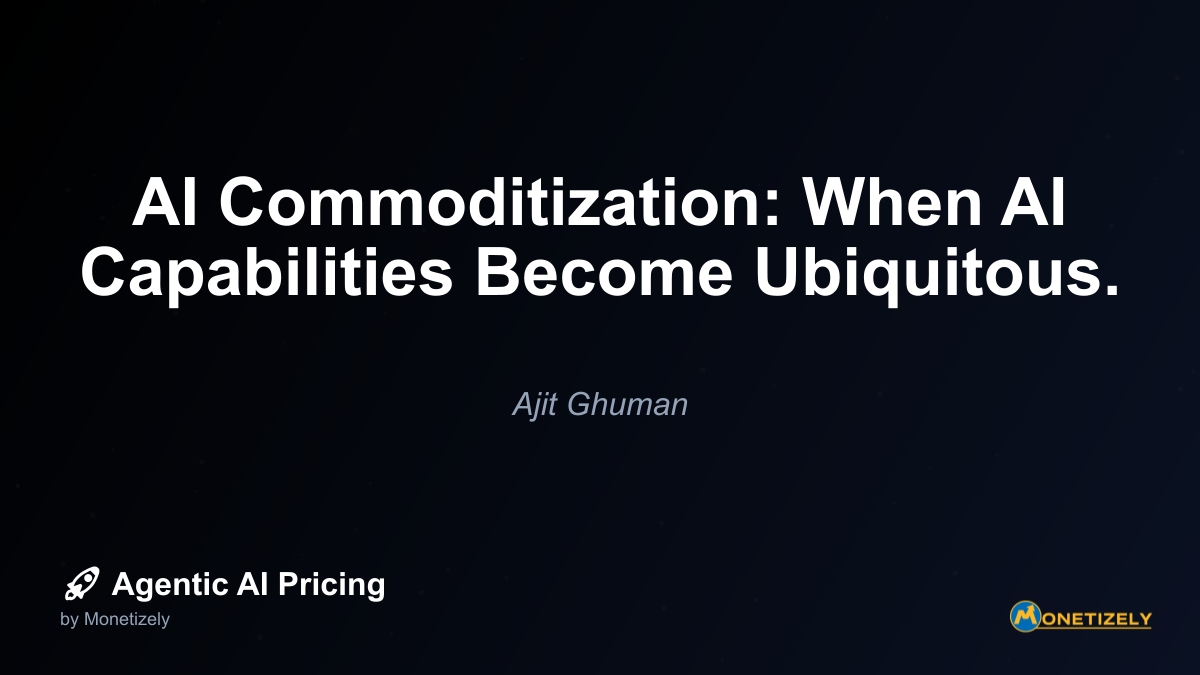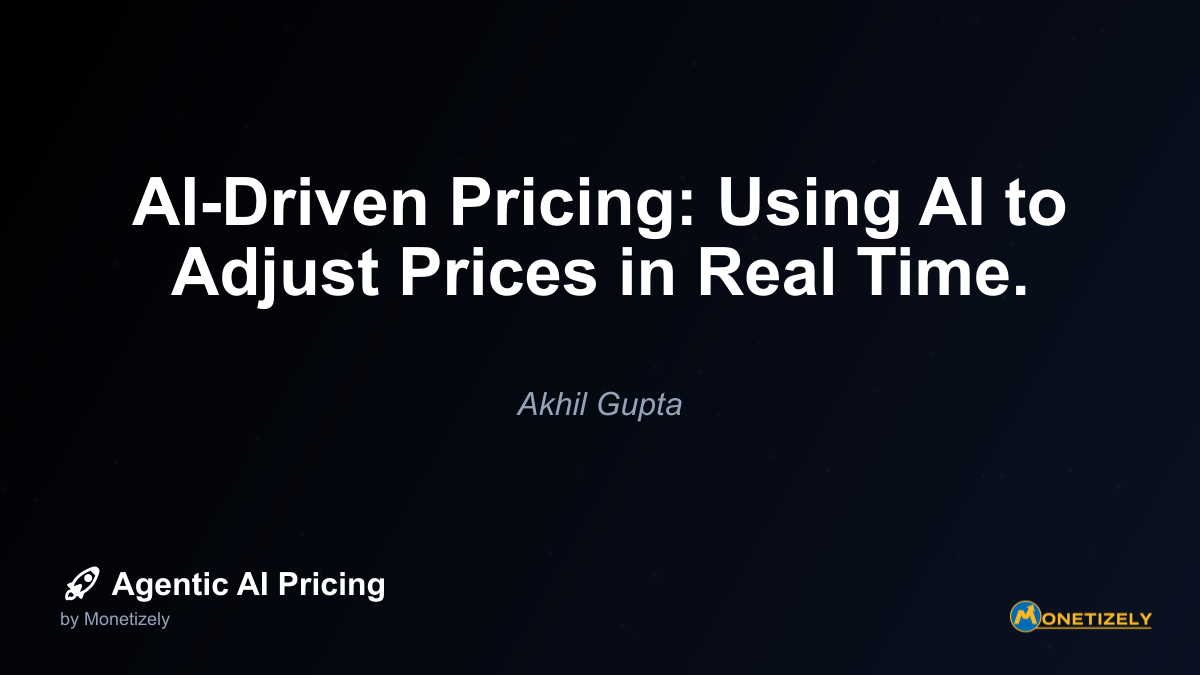· Ajit Ghuman · Emerging Trends · 6 min read
Economic Climate: Adapting AI Pricing in a Downturn.
AI and SaaS Pricing Masterclass
Learn the art of strategic pricing directly from industry experts. Our comprehensive course provides frameworks and methodologies for optimizing your pricing strategy in the evolving AI landscape. Earn a professional certification that can be imported directly to your LinkedIn profile.

IBM Watson’s “Pay As You Grow” Recession Strategy
During the 2008-2009 recession, IBM faced significant headwinds in selling its then-emerging Watson AI platform. Rather than maintaining rigid enterprise pricing, IBM implemented a “Pay As You Grow” model that fundamentally changed the risk equation for customers.
The approach featured:
- Initial implementations with minimal upfront costs
- Graduated pricing tied directly to quantifiable business outcomes
- Quarterly rather than annual commitment periods
- Built-in scaling mechanisms as economic conditions improved
This approach resulted in a 37% increase in new customer acquisition during the recession compared to pre-recession periods, according to IBM’s financial disclosures. More importantly, it established long-term relationships that expanded significantly once economic conditions improved.
Salesforce Einstein’s Modular Approach During COVID-19
When COVID-19 created sudden economic uncertainty in 2020, Salesforce adjusted its Einstein AI pricing strategy to accommodate customers facing budget constraints:
- Unbundled core Einstein capabilities from premium packages
- Created focused “Crisis Response” bundles with essential AI functions
- Implemented 90-day trial-to-paid conversion windows (extended from 30 days)
- Developed “Resume Growth” pricing plans activated when customer revenue recovered
This flexible approach allowed organizations to maintain critical AI capabilities during budget freezes while providing Salesforce protection against mass customer churn. According to their FY21 reporting, this strategy resulted in 76% of customers maintaining or increasing Einstein adoption despite economic challenges.
As discussed in our article on timing AI agent pricing during market uncertainty, companies that adopt flexible pricing models during economic downturns often emerge stronger when markets recover.
The Role of Free Tiers in Downturn Pricing Strategies
Free offerings take on special significance during economic contractions, serving as both customer acquisition tools and competitive defense mechanisms. However, successful free tier strategies during downturns differ substantially from growth economy approaches:
Value-Demonstrating Free Tiers
Effective recession-era free tiers focus on demonstrating concrete value rather than merely providing limited functionality:
- ROI calculator tools built directly into product experiences
- Business case generators that document potential savings
- Value-preview features showing outcomes before commitment
- Comparative analysis tools highlighting advantages over status quo
This approach shifts free offerings from “sample products” to “value validation tools” that directly address the heightened proof requirements during downturns.
Frictionless Migration Paths
Converting free users to paying customers during downturns requires careful attention to transition mechanics:
- Granular upgrade options starting with minimal commitments
- Data portability guarantees reducing switching costs
- Incremental capability unlocking rather than all-or-nothing conversions
- Success-triggered conversion recommendations based on demonstrated value
These approaches allow organizations to start with free offerings during maximum uncertainty and seamlessly transition to paid relationships as value is verified and economic conditions stabilize.
Pricing Communication Strategies During Economic Uncertainty
How AI vendors communicate pricing becomes as important as the pricing structure itself during downturns. Effective communication strategies include:
Emphasizing Cost Reduction Over Features
During growth periods, vendors typically highlight new capabilities and innovation. During downturns, messaging should pivot to:
- Total cost of ownership comparisons with existing solutions
- Operational efficiency metrics and labor reduction potential
- Resource optimization capabilities and utilization improvements
- Cost avoidance projections based on preventative capabilities
This approach positions AI not as an additional expense but as a cost-reduction mechanism—essential framing during budget contractions.
Transparent Risk Mitigation Language
Directly addressing risk concerns in pricing communications builds trust during uncertainty:
- Clear exit provisions and commitment limitations
- Performance guarantee details with specific remedy mechanisms
- Implementation milestone-based payments with defined deliverables
- Scaling provisions for both growth and contraction scenarios
By proactively addressing risk factors in pricing communications, vendors reduce perceived barriers to adoption even when budgets are constrained.
Implementation Timeline: Staged Approach to Pricing Adaptation
Transitioning pricing strategies during economic shifts requires careful sequencing to avoid disrupting existing customer relationships while addressing market needs:
Phase 1: Flexibility Enhancement (Immediate Response)
Initial actions focus on removing barriers within existing frameworks:
- Payment term extensions for current customers
- Temporary usage allowance increases without price changes
- Commitment reduction options for renewals
- Hardship provisions for most impacted customer segments
These changes can typically be implemented within existing pricing structures and systems, providing immediate market responsiveness.
Phase 2: Model Diversification (Medium-Term Response)
As economic conditions stabilize at new levels, more structural changes become appropriate:
- Introduction of alternative pricing models alongside existing options
- Development of outcome-based pricing mechanics
- Creation of modular offering structures
- Implementation of consumption-based alternatives
This phase typically requires 3-6 months for development and operationalization but provides more sustainable adaptation to economic conditions.
Phase 3: Strategic Repositioning (Long-Term Response)
Once economic patterns become clearer, fundamental repositioning may be warranted:
- Comprehensive value metric reassessment
- Competitive repositioning based on market evolution
- Development of counter-cyclical pricing mechanics
- Creation of economic condition-responsive pricing systems
This phase establishes pricing approaches that can dynamically adapt to changing economic conditions without requiring crisis response in future cycles.
Balancing Short-Term Adaptation with Long-Term Sustainability
While adapting to economic downturns is essential, vendors must balance immediate responsiveness with long-term business sustainability. Key considerations include:
Maintaining Value Perception Through Price Integrity
Price reductions or radical model changes risk devaluing AI solutions in customer perceptions. More sustainable approaches include:
- Maintaining headline prices while adjusting commitment structures
- Adding value components rather than reducing costs
- Creating temporary programs with clear expiration mechanisms
- Developing “economic recovery” pricing that scales with improvement
These approaches provide needed flexibility while protecting long-term value perception and pricing power.
Building Economic Sensitivity Into Pricing Architecture
Rather than treating economic adaptation as a crisis response, forward-thinking AI vendors are building economic sensitivity directly into pricing architectures:
- Economic indicator-linked pricing adjustments
- Countercyclical value metrics that remain relevant in different conditions
- Automatic scaling provisions tied to customer business performance
- Industry-specific economic response mechanisms
This approach transforms economic adaptation from reactive discounting to systematic value alignment across economic cycles.
The Competitive Advantage of Economic Responsiveness
Companies that effectively adapt pricing to economic conditions gain substantial competitive advantages beyond immediate customer retention:
- Increased market share during competitor vulnerability
- Enhanced brand reputation for partnership and understanding
- Improved customer loyalty translating to post-recovery expansion
- Accelerated displacement of legacy solutions unable to adapt
Research from the 2008 recession showed that companies with flexible pricing models gained an average of 8.5% market share during the downturn and maintained 5.3% of those gains after recovery, according to McKinsey analysis.
Measuring Success: KPIs for Downturn Pricing Strategies
Traditional pricing metrics like ARPU and conversion rates may send misleading signals during economic contractions. More appropriate success metrics include:
Customer Retention Metrics
- Logo retention rate - Percentage of customers maintained regardless of spending
- Relationship value retention - Total customer lifetime value preservation
- Expansion opportunity preservation - Maintenance of growth potential
- Competitive displacement prevention - Defense against competitor incursions
Financial Resilience Metrics
- Cash flow predictability - Consistency of revenue timing
- Cost-to-serve ratio - Efficiency of customer maintenance
- Discount depth containment - Limitation of permanent price erosion
- Recovery position strength - Ability to capture growth when conditions improve
These metrics provide more nuanced evaluation of pricing effectiveness during contractions than traditional growth-oriented measures.
Conclusion: Building Recession-Resilient AI Pricing
Economic downturns don’t change the fundamental value proposition of AI solutions—they change how that value must be packaged, priced, and communicated to overcome heightened risk sensitivity and budget constraints.
The most successful AI vendors during economic contractions will be those who:
- Shift risk dynamics to align with customer concerns
- Create flexible adoption paths requiring minimal initial commitment
- Directly connect pricing to measurable business outcomes
- Communicate value in terms of cost reduction and efficiency
- Build economic adaptability into core pricing architecture
By implementing these strategies, AI solution providers can maintain growth trajectories even during challenging economic periods while positioning themselves for accelerated expansion when conditions improve.
The companies that view economic adaptation not as a temporary discount exercise but as a fundamental alignment of pricing with customer economic realities will emerge from downturns with stronger market positions, deeper customer relationships, and more resilient business models.
For AI vendors, economic downturns represent not just challenges to be weathered but strategic opportunities to demonstrate true partnership with customers through pricing approaches that share both risk and reward across changing economic landscapes.
Co-Founder & CEO
Ajit is the author of Price To Scale, a top book on SaaS Pricing and is the Founder of Monetizely. Ajit has led and worked in pricing and product marketing at firms like Twilio, Narvar and Medallia. His work has been featured in Forbes and VentureBeat. Ajit regularly consults with software companies from Seed stage to post-IPO on pricing strategy. Ajit is also a highly-rated co-instructor for 'The Art of SaaS Pricing and Monetization' on Maven.
Pricing Strategy Audit
Let our experts analyze your current pricing strategy and identify opportunities for improvement. Our data-driven assessment will help you unlock untapped revenue potential and optimize your AI pricing approach.




